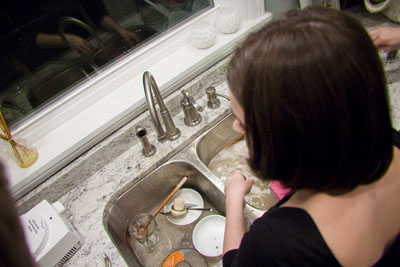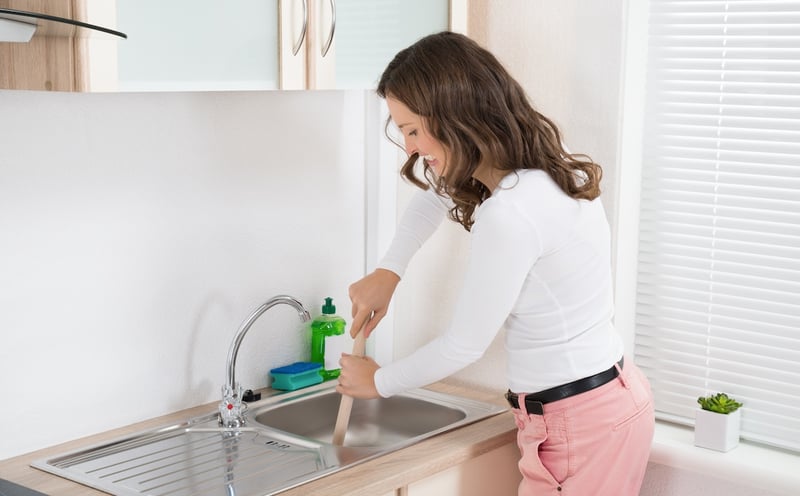Do you find yourself trying to find help around Repairing Common Household Plumbing Issues?

In this post, we will certainly be considering 5 basic steps you could require to release your cooking area sink from clogs and also conserve you from the discomfort and also shame of taking care of a clogged up kitchen sink.
Blocked kitchen area sinks are just one of one of the most usual drainage issues property owners deal with. And what's more, it's a undesirable and also extremely uncomfortable view. Visualize mosting likely to the sink to do your meals as well as finding out that the drainpipe is blocked and also water can not stream down easily.
The majority of blocked water drainages are brought on by food particles, oil, soap, as well as fat particles. They obstruct the sink and also make it hard for water to decrease the drain promptly. While it is appealing to put a call through to the plumbings, there are a couple of DIY hacks you could try initially prior to making that call.
1. Sodium Bicarbonate and also Vinegar
Instead of utilizing any kind of kind of chemicals or bleach, this method is much safer as well as not harmful to you or your sink. Baking soda and vinegar are everyday house products utilized for many various other things, as well as they can do the technique to your kitchen area sink.
Firstly, eliminate any water that is left in the sink with a cup.
Then put a good amount of cooking soft drink down the drain.
Pour in one mug of vinegar.
Seal the drainage opening and permit it to settle for some mins.
Pour warm water down the tubes to disappear other persistent deposit as well as bits.
Following this basic technique could suffice, as well as you can have your kitchen sink back. Repeat the procedure as long as you regard needed to rid the sink of this particles entirely.
2. Attempt a Plunger
You can try using a plunger if the trouble is not from the rubbish disposal. Plungers are basic house devices for this occasion, and also they can be available in helpful if you utilize them effectively. A flat-bottomed plunger is most suitable for this, but you can make do with what you have is a bathroom plunger.
Comply with the following straightforward actions to make use of the bettor properly:
Secure the drainpipe with a dustcloth and also fill up the sink with some warm water
Place the plunger ready over the drainpipe as well as start plunging
Check to see if the water runs openly after a couple of plunges
Repeat the procedure until the water drainage is complimentary
3. Maybe it's the Garbage Disposal
In lots of situations, the blockage might be due to a blockage in the disposal. Usage pliers instead.
If this does not function, you can discover the adhering to option to unclog your kitchen sink.
4. Utilize a Hanger
Using a cable fabric hanger or a plumber's serpent if you have one can do the technique. All you need do is straighten the wall mount to go down the drainpipe while you meticulously select out the bits triggering the clog.
Run hot water down the tubes hereafter to see just how effective you were.
5. Use Boiling Water
When faced with a stopped up sink, the first thing you need to attempt is to put boiling thin down the drainpipe. That has to do with the most simple treatment to clogged up sinks and also water drainages. Boiling water assists reduce the effects of the bits and debris creating the blockage, specifically if it's grease, oil, or soap bits, and oftentimes, it can flush it all down, and also your sink will certainly be back to normal.
Do not attempt this method if you have plastic pipelines (PVC) since warm water could melt the lines and also cause even more damages. You may want to stick to utilizing a bettor to obtain debris out if you use plastic pipes.
Using this technique, activate the faucet to see exactly how water flows after pouring warm water down the tubes. Attempt the process once more if the obstruction continues. Nonetheless, the obstruction could be more relentless in some cases as well as need more than just boiling water.
Final Words
Attempting these couple of methods might save you the expenses of having a plumber examine it. However in many cases, a plumber is what we require. In cases where you locate it difficult to unblock the sink also after attempting all these techniques, it might be time to leave it to the professionals.
Get in touch with professional plumbing firms to repair your drainage issues and other various family plumbing needs.
Blocked kitchen sinks are one of the most common drain problems homeowners deal with. Think of going to the sink to do your meals and also locating out that the drain is clogged as well as water can not stream down easily.
They obstruct the sink as well as make it hard for water to go down the drain swiftly. When encountered with a blocked sink, the first point you should try is to put boiling water down the drain. Boiling water helps neutralize the fragments and also particles creating the blockage, especially if it's oil, soap, or grease fragments, as well as in numerous instances, it can purge it all down, and your sink will be back to normal.
How to Unclog a Kitchen Sink
Take the Plunge
Start your efforts by plunging. Use a plunger with a large rubber bell and a sturdy handle. Before getting to work on the drain, clamp the drain line to the dishwasher. If you don t close the line, plunging could force dirty water into the dishwasher.
Fill the sink with several inches of water. This ensures a good seal over the drain.
If you have a double sink, plug the other drain with a wet rag or strainer.
Insert the plunger at an angle, making sure water, not air, fills the bell.
Plunge forcefully several times. Pop off the plunger.
Repeat plunging and popping several times until the water drains.Clean the Trap
The P-trap is the curved pipe under the sink. The trap arm is the straight pipe that attaches to the P-trap and runs to the drain stub-out on the wall. Grease and debris can block this section of pipe. Here s how to unclog a kitchen sink by cleaning out the trap:
Remove as much standing water from the sink as possible.
Place a bucket under the pipe to catch the water as it drains.
Unscrew the slip nuts at both ends of the P-trap. Use slip-joint pliers and work carefully to avoid damaging the pipes or fasteners.
If you find a clog, remove it. Reassemble the trap.
If the P-trap isn t clogged, remove the trap arm and look for clogs there. Run the tip of a screwdriver into the drain stub-out to fetch nearby gunk.Spin the Auger
With the trap disassembled, you re ready to crank the auger down the drain line.
Pull a 12-inch length of cable from the auger and tighten the setscrew.
Insert the auger into the drain line, easing it into the pipe.
Feed the cable into the line until you feel an obstruction. Pull out more cable if you need to.
If you come to a clog, crank and push the cable until you feel it break through. The cable will lose tension when this happens.
Crank counterclockwise to pull out the cable, catching the grime and debris with a rag as the cable retracts.

Do you really like reading up on Repairing Common Household Plumbing Issues? Give a remark directly below. We'd be glad to know your feelings about this content. We hope to see you back again before long. Liked our write-up? Please share it. Help someone else discover it. We cherish reading our article about Common Household Plumbing Issues.
Quick fix? Dial!